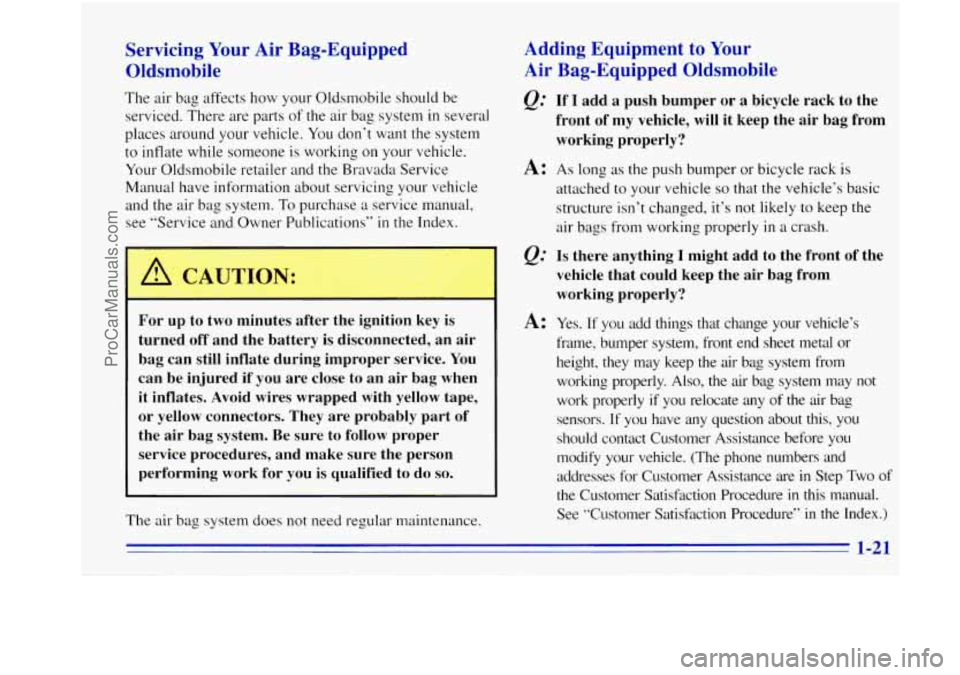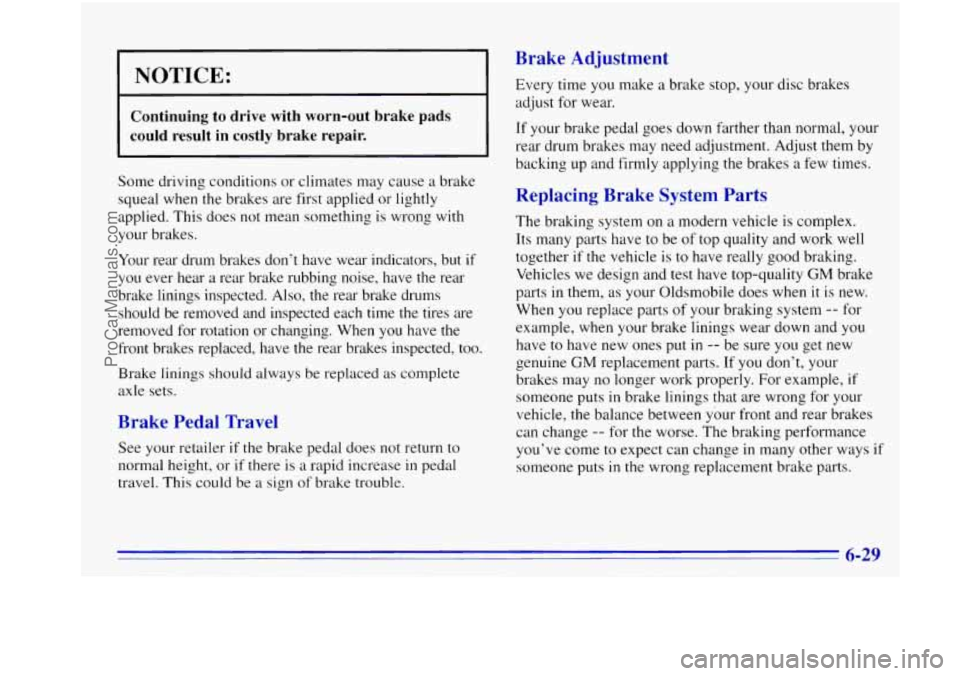height OLDSMOBILE BRAVADA 1996 Owners Manual
[x] Cancel search | Manufacturer: OLDSMOBILE, Model Year: 1996, Model line: BRAVADA, Model: OLDSMOBILE BRAVADA 1996Pages: 340, PDF Size: 17.49 MB
Page 29 of 340

Servicing Your Air Bag-Equipped
Oldsmobile
The air bag affects how your Oldsmobile should be
serviced. There are parts
of the air bag system in several
places around your vehicle. You don’t want the system
to inflate while someone is working on your vehicle.
Your Oldsmobile retailer and the Bravada Service
Manual have information about servicing your vehicle
and the air bag system.
To purchase a service manual,
see “Service and Owner Publications”
in the Index.
A CAUTION:
-
For up to two minutes after the ignition key is
turned off and the battery is disconnected, an air
bag can still inflate during improper service. You
can be injured if you are close to an air bag when
it inflates. Avoid wires wrapped with yellow tape,
or yellow connectors. They are probably part of
the air bag system. Be sure to follow proper
service procedures, and make sure the person
performing work for you is qualified to do
so.
The air bag system does not need regular maintenance.
Adding Equipment to Your
Air Bag-Equipped Oldsmobile
If I add a push bumper or a bicycle rack to the
front of my vehicle, will it keep the air bag from
working properly?
A: As long as the push bumper or bicycle rack is
attached to your vehicle
so that the vehicle’s basic
structure isn’t changed, it’s not likely to keep
the
air bags from working properly in a crash.
Is there anything I might add to the front of the
vehicle that could keep the air bag from
working properly?
A: Yes. If you add things that change your vehicle’s
frame, bumper system, front end sheet metal or
height, they may keep the air bag system from working properly. Also,
the air bag system may not
work properly
if you relocate any of the air bag
sensors. If you have any question about this, you
should contact Customer Assistance before you
modify your vehicle. (The phone numbers and
addresses for Customer Assistance are
in Step Two of
the Customer Satisfxtion Procedure
in this manual.
See “Customer Satisfaction Procedure’’
in the Index.)
ProCarManuals.com
Page 241 of 340

1 NOTICE:
Continuing to drive with worn-out brake pads
could result in costly brake repair.
Some driving conditions or climates may cause a brake
squeal when the brakes are first applied or lightly
applied. This does not mean something is wrong
with
your brakes.
Your rear drum brakes don’t have wear indicators, but
if
you ever hear a rear brake rubbing noise, have the rear
brake linings inspected. Also, the rear brake drums
should be removed and inspected each time the tires are
removed for rotation or changing. When you have
the
front brakes replaced, have the rear brakes inspected, too.
Brake linings should always be replaced as complete
axle sets.
Brake Pedal Travel
See your retailer if the brake pedal does not return to
normal height, or if there is
a rapid increase in pedal
travel. This could be
a sign of brake trouble.
Brake Adjustment
Every time you make a brake stop, your disc brakes
adjust for wear.
If your brake pedal goes down farther than normal, your
rear drum brakes may need adjustment. Adjust them by
backing up and firmly applying the brakes a few times.
Replacing Brake System Parts
The braking system on a modern vehicle is complex.
Its many parts have to be of top quality and work well
together
if the vehicle is to have really good braking.
Vehicles we design and test have top-quality
GM brake
parts
in them, as your Oldsmobile does when it is new.
When you replace parts
of your braking system -- for
example, when your brake linings wear down and
you
have to have new ones put in -- be sure you get new
genuine
GM replacement parts. If you don’t, your
brakes
may no longer work properly. For example, if
someone puts in brake linings that are wrong for your
vehicle, the balance between your front and rear brakes
can change
-- for the worse. The braking performance
you’ve come to expect can change
in many other ways
someone puts
in the wrong replacement brake parts. if
ProCarManuals.com
Page 255 of 340

I A CAUTION:
Using the wrong replacement wheels, wheel bolts
or wheel nuts on your vehicle can be dangerous.
It could affect the braking and handling
of‘ your
vehicle, make your tires
lose air and make you
lose control. You could have a collision in which
you or others could be injured. Always use the
correct wheel, wheel bolts and wheel nuts
for replacement.
NOTICE:
The wrong wheel can also cause problems with
bearing life, brake cooling, speedometer or
odometer calibration, headlamp aim, bumper
height, vehicle ground clearance and tire
clearance to the body and chassis.
See “Changing
a Flat Tire” in the Index for
more information.
Used Replacement Wheels
Putting
a used wheel on your vehicle is dangerous.
You can’t know how it’s been used or how many
miles
it’s been driven. It could fail suddenly and
cause an accident. If
you have to replace a wheel,
use
a new GM original equipment wheel.
Tire Chains
I NOTICE:
Don’t use tire chains. They can damage
your vehicle.
ProCarManuals.com
Page 270 of 340

Capacities (Approximate)
Cooling System* ............. 11.7 quarts (1 1.1 L)
Crankcase with Filter* .......... 4.5 quarts (4.3 L)
Automatic Transmission
(Drain and Refill)*
........... 5.0 quarts (4.7 L)
Differential Fluid (Rear) ......... 4.0 pints ( 1.9 L)
Differential Fluid (Front) ......... 2.6 pints (1.2 L)
Fuel Tank ..................... 18 gallons (68 L)
A/C Refrigerant ........ 30 oz. or 2 lbs. (0.9 kg) of
R- 134a
*After refill, the level
must be checked.
A- I Co:~ ~ Jitioning Refrigerants
not all air conditioning refrigerants are the same.
If the air conditioning system in your vehicle needs
refrigerant, be sure the proper refrigerant is used.
If you’re
not sure, ask your Oldsmobile retailer.
Vehicle Dimensions*
Wheelbase .............. 107.0 inches (271.8 cm)
Length
................. 180.9 inches (459.5 cm)
Height ................... 63.2 inches (160.5 cm)
Width ................... 67.6 inches (17 1.7 cm)
Front Tread
............... 57.3 inches (145.4 cm)
Rear Tread
............... 55.1 inches (139.9 cm)
*Figures reflect base equipment
only.
ProCarManuals.com